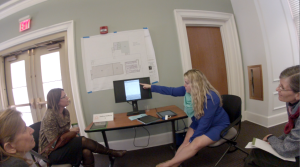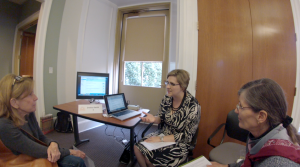Today our guest blogger is Dr. Kelley White, Assistant Professor in Teacher Education.
I was fortunate to have the opportunity to attend the summer 2013 FTI (Faculty Technology Institute). It was a great experience for many reasons. I met and collaborated with new colleagues and learned about several new tools that could enhance my teaching and research. Based on what we learned about video projects, I decided to require students in two different courses to create videos as part of their final projects in the course. In both classes, students were required to choose a topic of interest, read research on the topic and write an annotated bibliography. Then, they were to choose an audience (parents, children, elementary school teachers, or community members) and create a video to share what they learned about the topic in a meaningful way. I used a similar assignment in the past, but often simply required students to present their work using PowerPoint for the final presentation. After seeing what other colleagues had done with video, I thought using video might challenge my students to present their work in a more creative way. I was particularly interested in how they would create the video with specific consideration of the audience they selected. A majority chose to make videos for parents or teachers, but I had one create a video for young children.
As far as tools go, I gave the students the choice of using iMovie, MovieMaker, VoiceThread or Splice, but a majority of the students chose to use iMovie. Honestly, I did not provide a whole lot of support to them in class in regards to use of technology or in creating the videos beyond providing them with a rubric. I did make myself available for individual meetings if needed, but very few requested them. The majority of the rubric focused on evaluation of video content, implications and consideration of audience, but I also evaluated creativity, editing and video construction. Looking back though, the rubric needed to be much more specific in differentiating levels of quality in regards to “good editing” and “smooth transitions.” It’s also important to note that this criteria was worth only 15% of the grade on the project so it may have needed to become a more significant portion of the grade in order for students to better understand its importance.
As mentioned previously, I used different versions of this project in both a freshman class and a graduate course. In the freshman course, students worked collaboratively to create the videos. In the graduate course, it was an individual assignment and the requirements for topic selection, length of video, annotated bibliography and sources were more rigorous. As you might expect, the projects were fairly different in quality. The freshmen did not seem to be as concerned with quality of the video. Several had major problems with audio and transitions. Whereas it was obvious that most of the graduate students spent a good deal of time editing and polishing their work. The graduate students were also much more thoughtful in their consideration of audience and in how they integrated research and theory.
If I were to do this again, I would provide more support across the semester to the freshmen in particular. I would require them to check in with me at least once prior to the end of the semester with a detailed plan for the video. Perhaps, requiring them to plan their video using a storyboard and incorporate it into their grade. I also would take more time to better review my expectations for quality of the video (beyond what I included on the rubric), show more examples, and spend more time in class teaching them how to appropriately edit. Finally, I would also consider requiring use of a specific tool (Splice, for example) so we could troubleshoot and discuss video construction and quality together as a class. Overall, it was a good experience for me and for the students and I would definitely try it again.
Rubric available upon request







